 Home > Bart Beaty's Conversational Euro-Comics
Home > Bart Beaty's Conversational Euro-Comics Conversational Euro-Comics: Bart Beaty On Comics, Manga And Co.: The New Culture Of German Comics
posted September 16, 2010
Conversational Euro-Comics: Bart Beaty On Comics, Manga And Co.: The New Culture Of German Comics
posted September 16, 2010

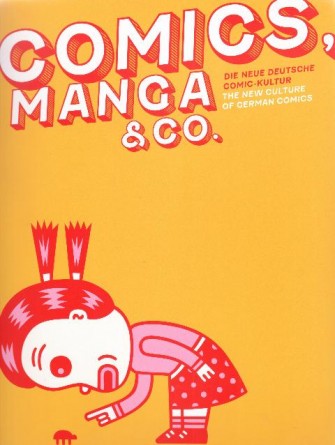 By Bart Beaty
By Bart Beaty
Even though my German is lousy -- and I have friends who would use a much less charitable adjective than that to describe it -- I've had a keen interest in German comics for about 15 years. Over that time, the Germans have released some remarkable anthologies and developed first-rate publishing houses. More importantly, key figures in German comics have become among the most interesting cartoonists working anywhere on the planet.
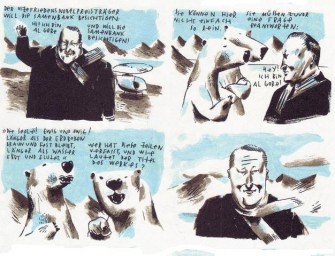
I was forcefully reminded of that when I opened my mailbox this week to find a copy of a new catalogue published by
the Goethe-Institut, titled
Comics, Manga and Co.: The New Culture of German Comics. This beautifully produced, 88-page catalogue highlights the work of 13 German cartoonists representing two generations. Generously illustrated with full-color examples of their art, the book also contains a short, but very smart, introduction by journalist
Andreas Platthaus that is presented in both German and English. Additionally, all of the works introduced in the book are presented in both languages (though, sadly, the text in the actual examples themselves is only in German). This is a perfect single-volume introduction to a series of great creators and will set you back less than a trip to Berlin. The catalogue complements
a traveling exhibition of comics art curated by Matthias Schneider.
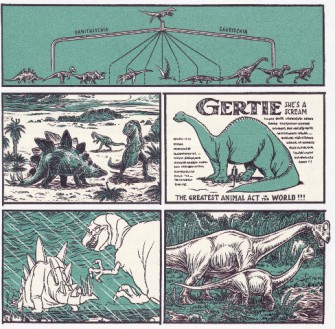
Platthaus makes the argument that the key development in German comics was reunification, suggesting that much of the energy to drive German comics came from the former German Democratic Republic. Artists like
Anke Feuchtenberger and
Henning Wagenbreth (both featured here) helped form a nucleus of
avant-garde inspired cartoonists in Berlin in the 1990s. This first wave has had a tremendous impact on German cartooning, not only from the example of their own unique works, but now as teachers. Significantly, stars of the 1990s German comics scene -- Feuchtenberger, Wagenbreth,
Henrik Dorgathen,
Martin tom Dieck, and
Atak -- are all art instructors, and have helped to nurture a comics-friendly climate in which younger artists have developed.
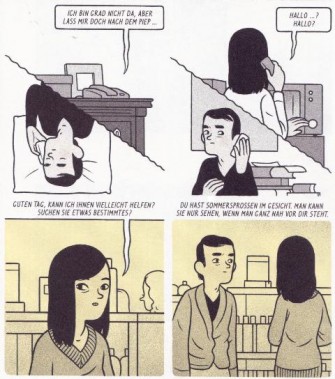
Those younger artists are featured here in good number, including
Ulf K.,
Reinhard Kleist,
Mawil,
Sascha Hommer and
Jens Harder. If these names aren't familiar to you, you need to pick up this book, as they are all fantastic creators. For me, the book was a revelation in a couple of other areas. I knew
Arne Bellstorf's work from seeing his 2005 book
Acht, Neun, Zehn (Reprodukt) which has a sort of a
Paul Hornschmeier or early
Dan Clowes feeling to it. The pages reproduced here from
Baby's in Black (Reprodukt, 2010), which tells the story of the Beatles'
Stuart Sutcliffe and
Astrid Kirchherr in Hamburg, look simply astounding. I need to read this book.
Flix, who produces a strip about the division of Germany in
Da War Mal Was... has a super-friendly, slick style that seems utterly charming. German mangaka
Christina Plaka's
Yonen Buzz testifies to how quickly the German scene has been internationalized.
This was a great book for me because I learned about new projects from artists that I've long followed, but, more importantly, discovered several new artists that I want to check out. That's about all I could have hoped from this book -- to have my comics horizons broadened just a little bit more.
*****
*
Comics, Manga And Co.: The New Culture Of German Comics, Goethe Institut, 88 pages, ISBN 978-3-939670-38-4.
*****
* cover
* Martin tom Dieck
* Jens Harder
* Arne Bellstorf
* Sascha Hommer (below)
*****
To learn more about Dr. Beaty, or to contact him,
try here.
Those interested in buying comics talked about in Bart Beaty's articles might try
here.
*****
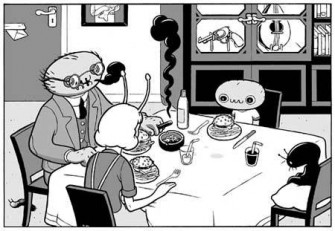
*****
*****


